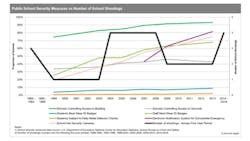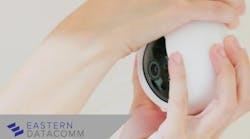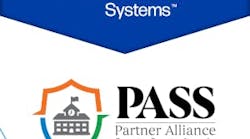In the aftermath of the recent shooting massacre at Marjory Stoneman Douglas High School in Parkland, Florida, there has been the expected hue and cry from politicians and school leaders across the country about the need to bolster student safety by deploying security equipment and personnel where necessary. However, a new report from IHS Markit shows that there is little room for growth in the adoption of school security systems in the U.S. as many newer schools have already adopted video surveillance, electronic access control and other traditional security systems, thus reducing the number of potential “greenfield” projects for suppliers.
In fact, the market research firm predicts that the education sector of the market for security equipment and services, which reached $2.7 billion in revenue in 2017, will grow at an average of just one percent annually over the next several years, reaching $2.8 billion by 2021. According to the National Center for Education Statistics, the proportion of schools deploying video surveillance systems has risen from 20 percent in 1999 to over 70 percent in 2013. Likewise, the proportion of schools actively controlling the entrances to their buildings has risen from 75 percent to over 90 percent.
And despite advancements in the level of security used on school premises, the number of mass shootings at U.S. schools has remained relatively constant throughout the past 30 years. When looking specifically at secondary schools, the number of mass shootings has actually reached an unprecedented high in the past five years.
Despite these challenges, Jim Dearing, Senior Analyst for Security and Building Technologies at IHS Markit, said that security manufacturers are looking to implement a variety of new technologies to improve school safety, which could also help to reignite market growth. These technologies include:
1. Facial Recognition
Many of the video surveillance systems currently used in schools are not actively monitored and also rarely lack any form of effective automated response. Adoption of facial recognition technology would enable surveillance systems to proactively search for potential threats and alert school administrators and security staff about unrecognized individuals in the building. Unfortunately, affordable facial recognition technologies are often unable to adequately recognize the number of faces in a typical school. In addition, these systems can place a large strain on a school’s information technology network.
2. Logical and Physical Security Identity Management Integration
Integrating a school’s access control database with a higher authority logical database — for example, a student directory — would allow the access rights of former staff, and students who have been expelled or already graduated, to be removed automatically. However, Dearing said that access control providers may find it difficult to get permission to access student records and other sensitive data. Education administrators may also be uncomfortable with possibly creating a potential avenue of cyber-attack.
3. High-Security Classroom Doors with Multipoint Locking Systems
Higher-grade doors would create a far more effective barrier between students and potential attackers, creating numerous safe spaces throughout the building in emergencies. It’s also true, though, that purchasing thousands of doors would be expensive. Fire regulations often dictate that key entrances and exits remain fail-safe during emergencies. Locking and unlocking doors multiple times would also disrupt teaching.
4. Weapons Checks Using Metal Detectors or X-Ray Machines at School Entrances
Using metal detectors or x-ray machines at entrances along the school perimeter makes bringing weapons into the school much more difficult. However, schools often have multiple entrances, which mean each school would require multiple detectors or x-ray machines—both of which are expensive. The school would also need to hire additional security staff to operate each machine. Securing entrances in this manner would also mean long queues would form after breaks and lunchtime, reducing the free time of students and staff.


